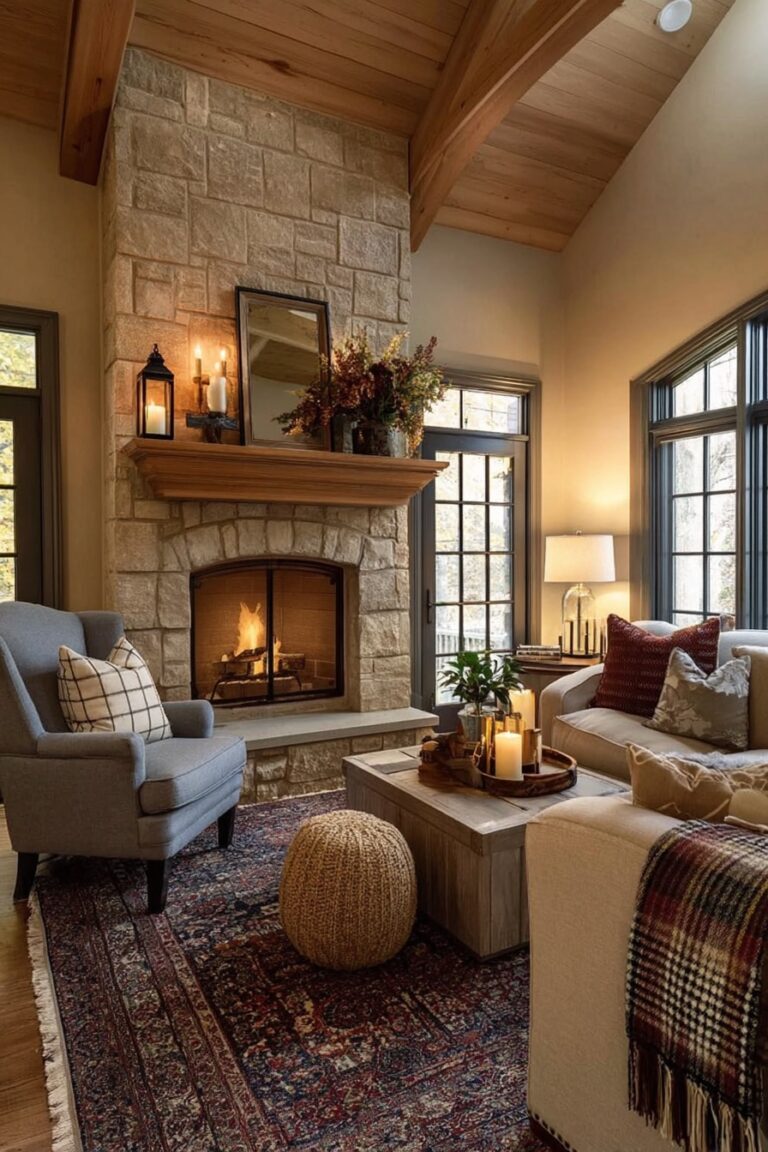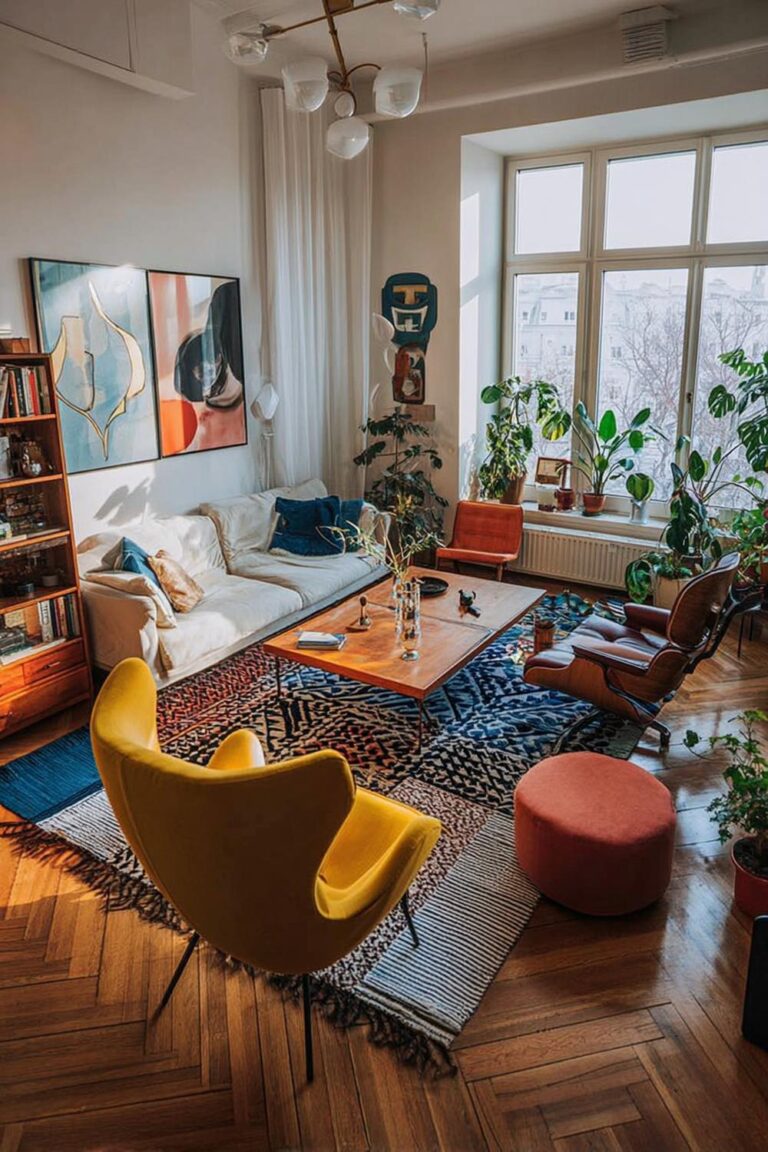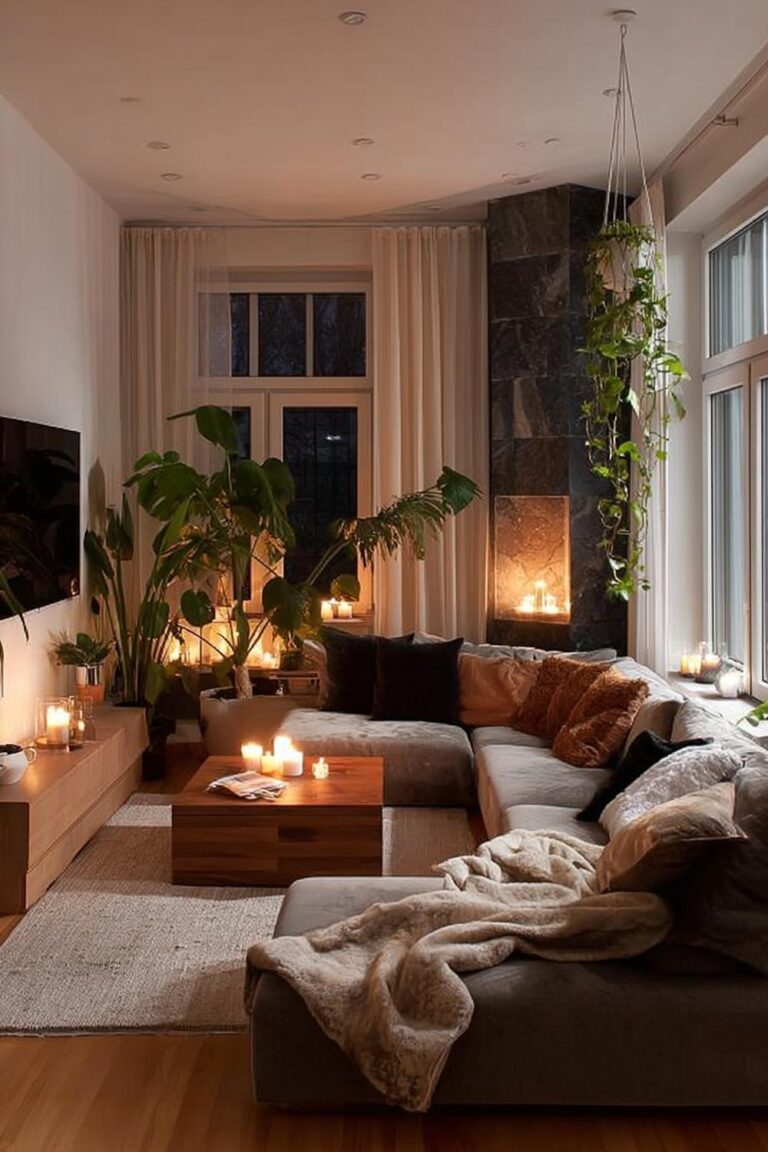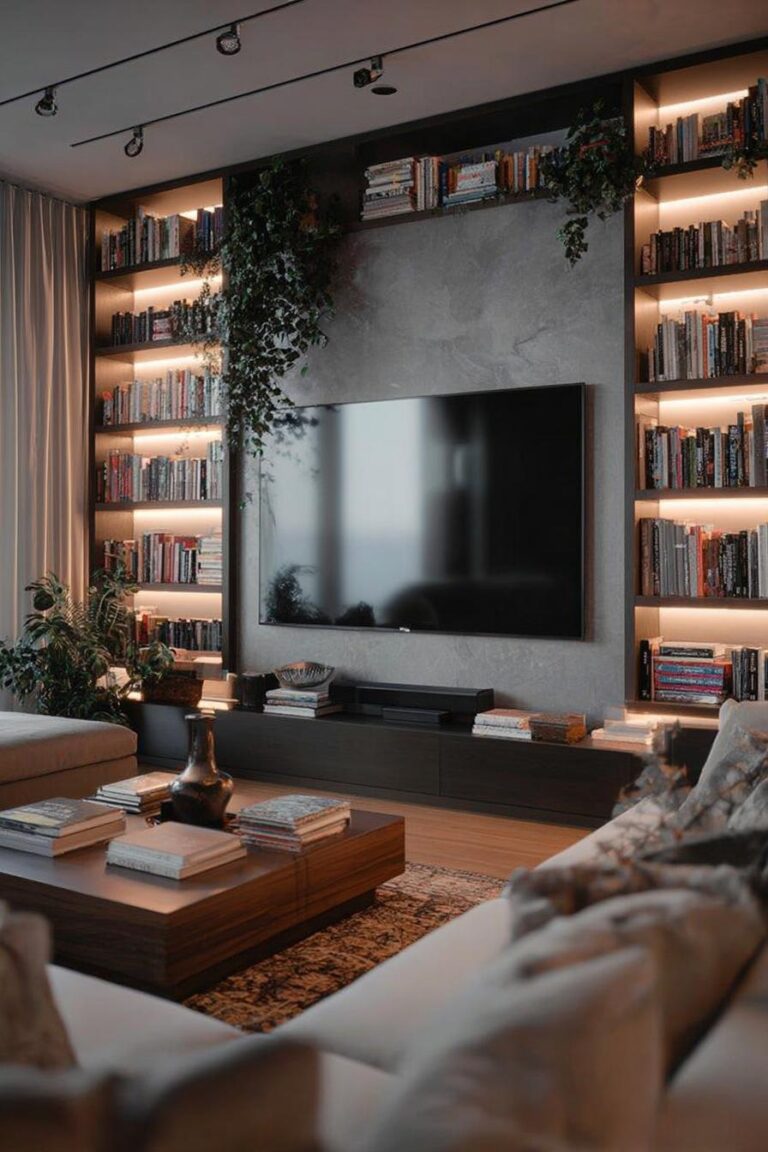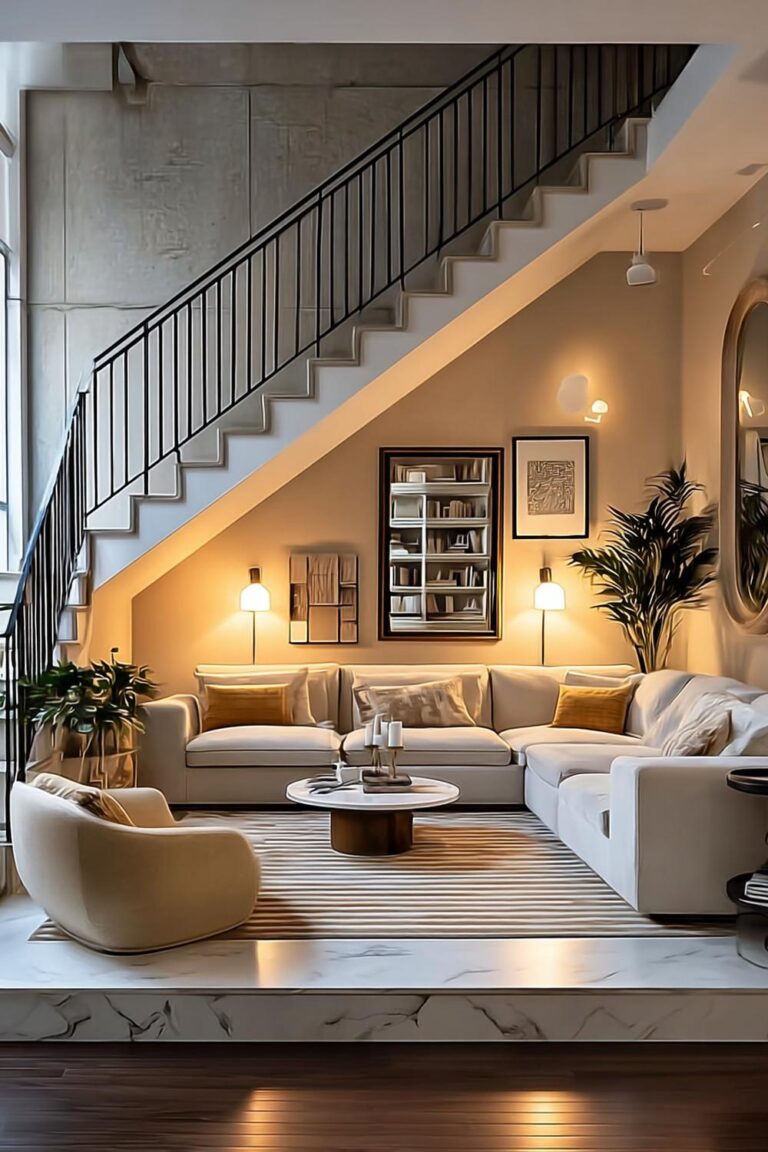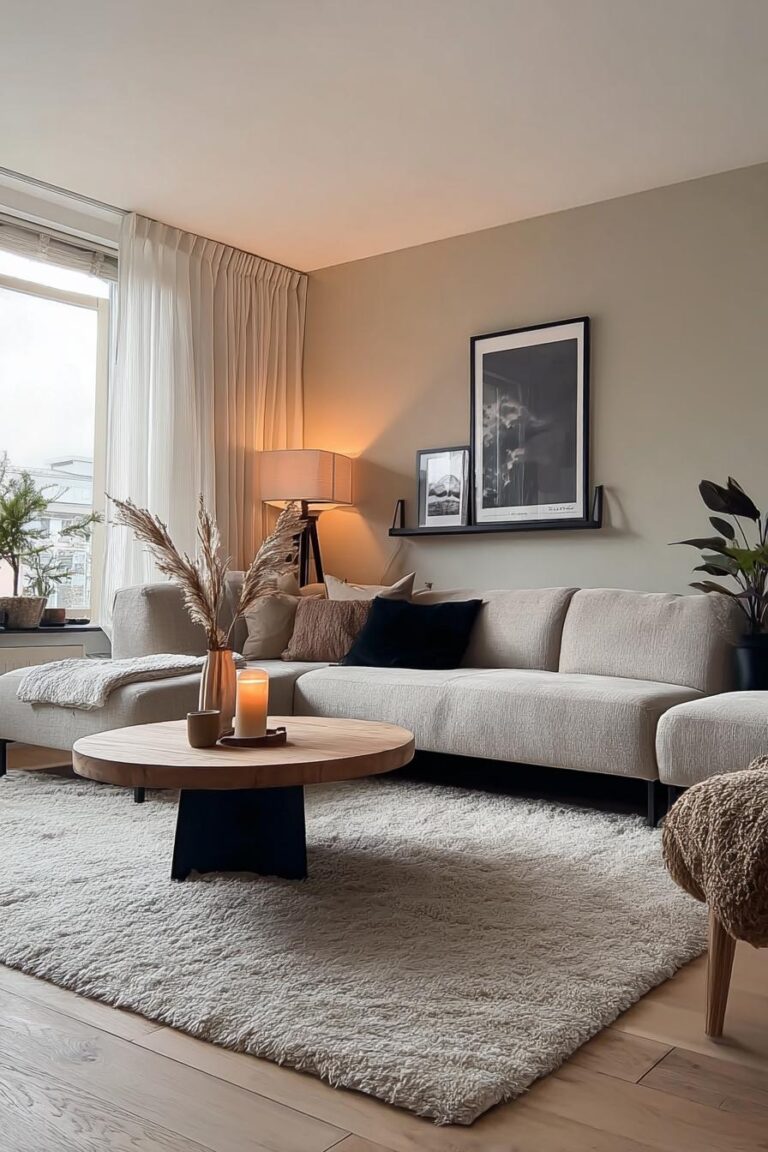Creating a harmonious living-dining combination challenges even seasoned decorators. The key lies in establishing distinct zones while maintaining visual flow – a delicate dance between separation and unity.
When you merge two essential spaces, every design choice carries double weight. Smart solutions transform potential chaos into sophisticated cohesion, whether you’re working with a sprawling loft or a compact studio.
1. Brighten the Dining Table with Clustered Candle Lighting Ideas

If you’ve ever dined in a restaurant with flickering candlelight, you already know the magic it creates. Clustering various heights of pillar candles or mixing votives with tapered candles builds layers of warm illumination that transforms ordinary Tuesday dinners into something memorable.
The soft glow draws people toward the dining area, creating an invisible boundary between eating and lounging spaces – though you might say it’s more like a gentle suggestion than a firm line.
This approach works particularly well when you position candles on a mirrored tray or metallic surface, doubling their impact through reflection. Just remember: real flames near curtains or low-hanging plants spell disaster, so consider battery-operated alternatives if your dining table sits close to fabric or foliage.
2. Highlight Natural Wood Grain on Dining Table For Modern Colors

Who says wood furniture belongs only in rustic farmhouses? A walnut or oak dining table with visible grain patterns becomes the star when you surround it with crisp whites and cool grays.
The organic texture grounds your modern palette, preventing that sterile gallery feel that sometimes creeps into contemporary spaces. Plus, wood ages gracefully – those inevitable dinner party scratches add character rather than diminish value.
3. Use Large Round Pendant Light to Enhance Modern Lighting

Why do round pendant lights work so brilliantly above dining tables? Their circular shape echoes the gathering motion of shared meals, drawing eyes upward while defining the eating zone without walls.
Picture a matte black metal sphere or frosted glass globe hovering three feet above your table – suddenly, that corner transforms into a designated dining destination.
The fixture serves as both sculpture and illumination source, eliminating the need for additional artwork in smaller spaces. This lighting choice bridges seamlessly into open-plan living, especially when you select materials that echo elsewhere in your decor.
4. Create Cohesion with Neutral Gray Sofa and Coordinated Accents
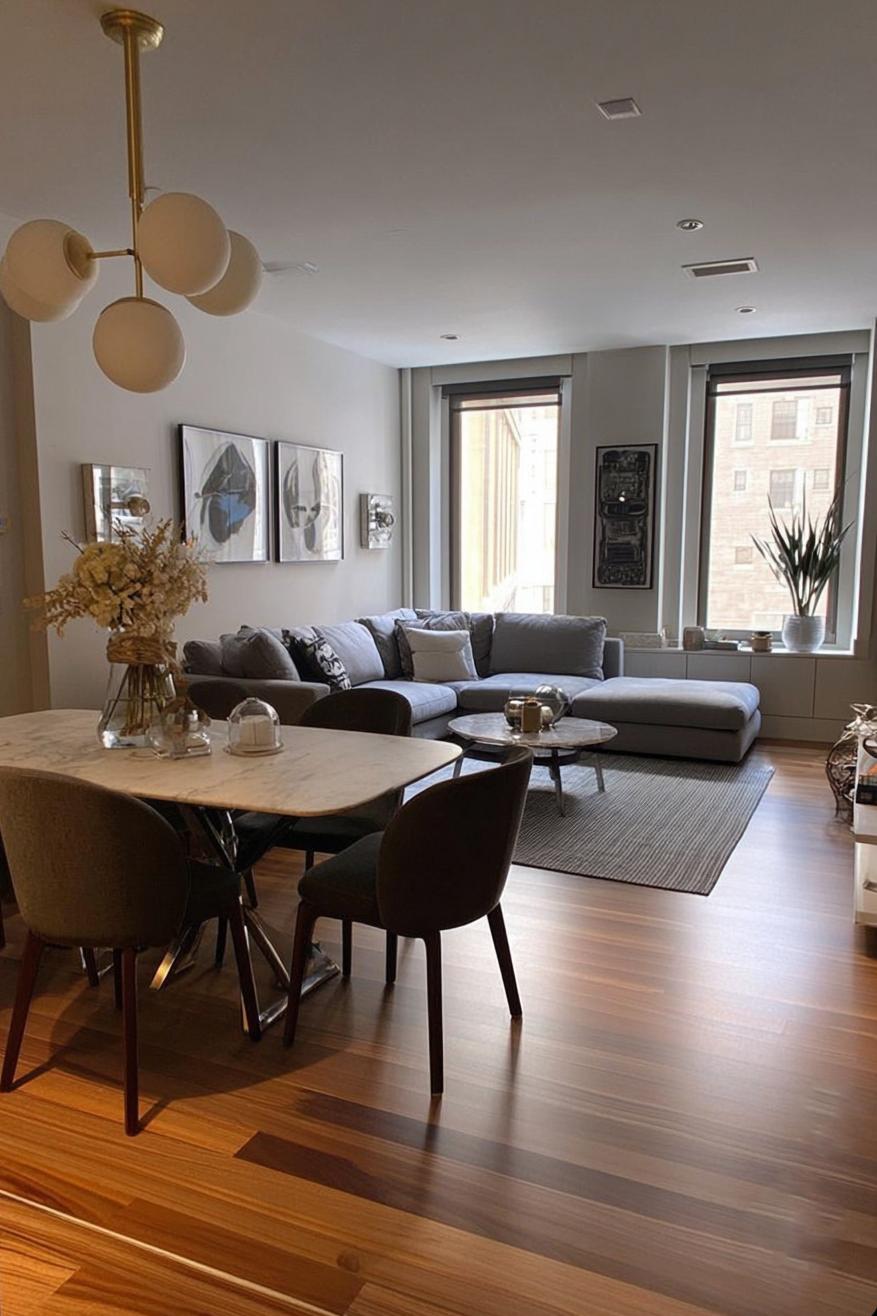
Start with a dove-gray sofa as your anchor piece. Then weave that same gray through dining chair cushions, table runners, or artwork frames – suddenly, two separate areas speak the same visual language.
The beauty emerges when you watch how morning light shifts these gray tones from cool silver to warm pewter, creating subtle mood changes throughout your day.
5. Elevate the Dining Area with Clear Glass Bubble Pendant Lighting
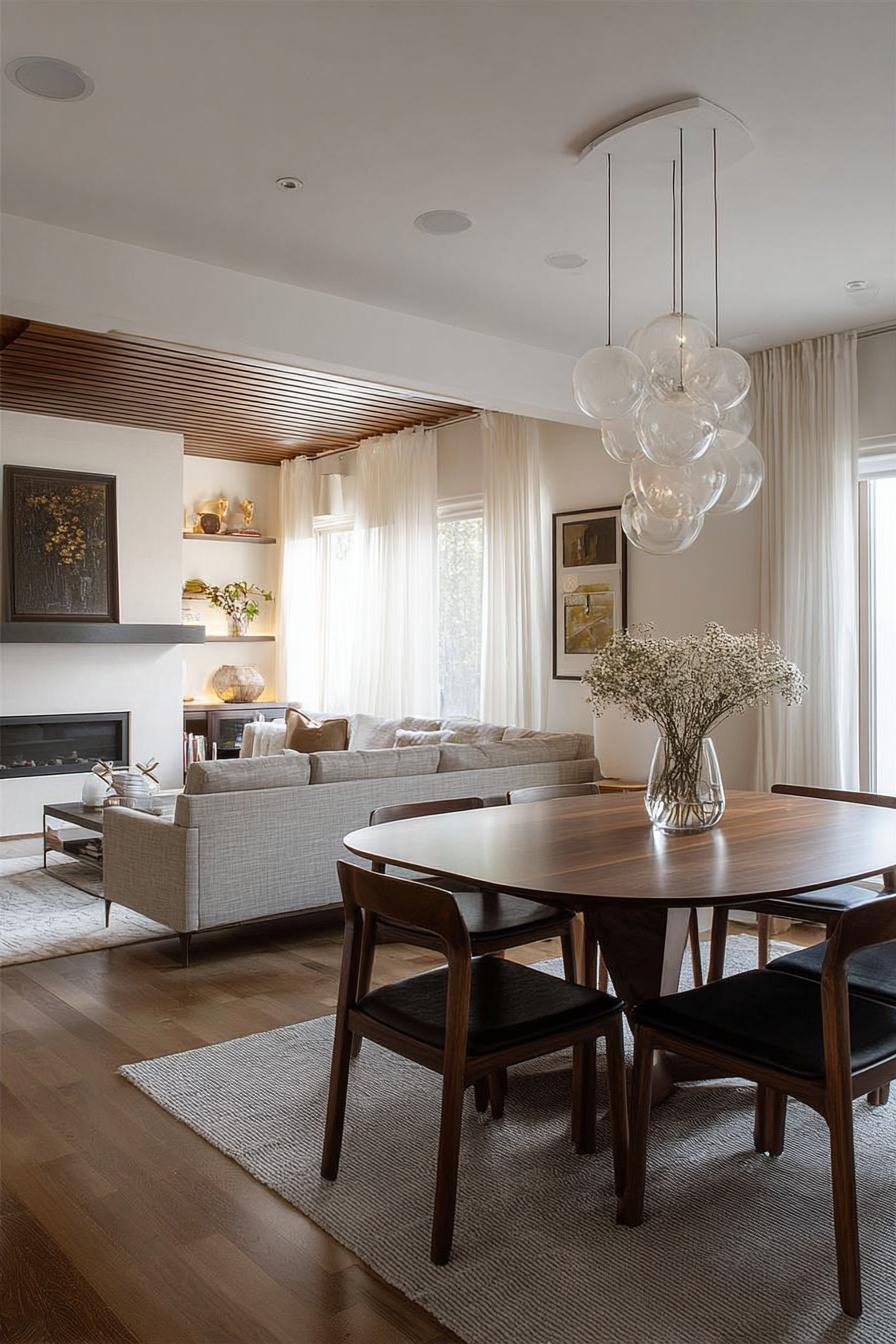
Like champagne bubbles frozen mid-rise, glass sphere pendants bring weightless elegance to dining spaces. These fixtures cast intricate shadow patterns during daylight hours, transforming into glowing orbs after sunset – a twice-daily performance that never grows old.
The transparency prevents visual blockage between living and dining zones, maintaining that precious sense of openness.
You’ll find these fixtures appearing everywhere from Scandinavian showrooms to Manhattan lofts, suggesting their staying power extends well beyond current trends.
6. Emphasize Natural Light with Sheer Window Curtains For Long Space

While heavy drapes create cozy cocoons, sheer curtains invite sunshine to dance across both living and dining areas simultaneously. The filtered light softens harsh shadows, flattering both your morning coffee ritual and evening Netflix sessions.
In narrow galley-style combos, this transparency prevents that tunnel feeling that opaque window treatments sometimes create.
Beyond aesthetics, sheers offer practical flexibility – layer them with blackout panels when you need privacy or darkness. Consider hanging curtains closer to the ceiling than the window frame; this trick makes windows appear larger and rooms feel taller.
7. Install Varied Round Mirrors to Expand Light and Space in Apartment
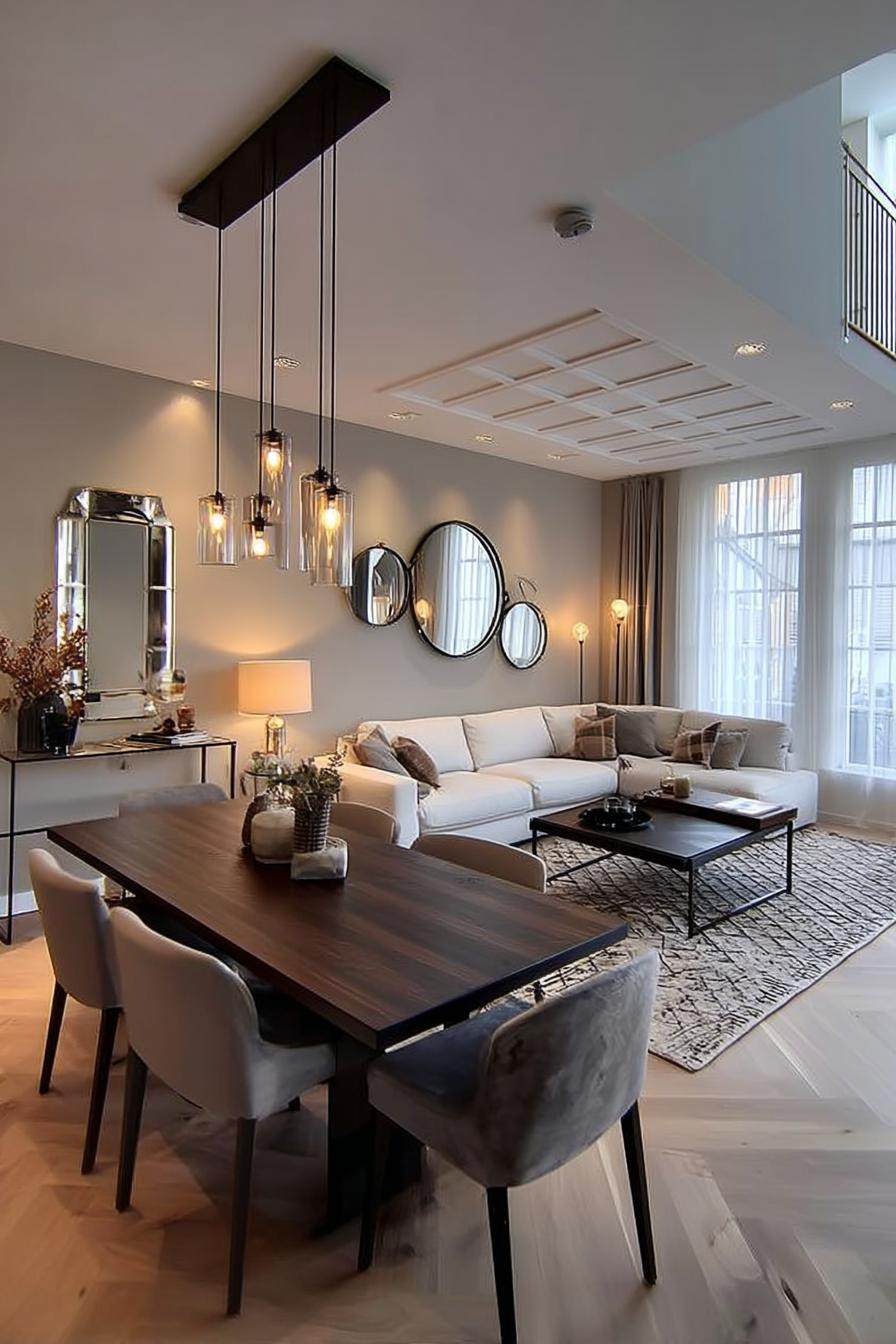
Mirrors multiply everything – light, views, and perceived square footage. Arranging different-sized circular mirrors in an organic cluster creates an artistic focal point while bouncing daylight deeper into your combo space.
Position them strategically to reflect your favorite view or chandelier, essentially getting two decorative elements for the price of one.
The reflection game becomes even more interesting when mirrors catch glimpses of both living and dining areas, visually connecting the zones through their surfaces. Small mirrors work harder than you’d expect; even a 12-inch convex mirror can brighten a dim corner considerably.
8. Use a Vintage Persian Rug to Define Living Room Colors
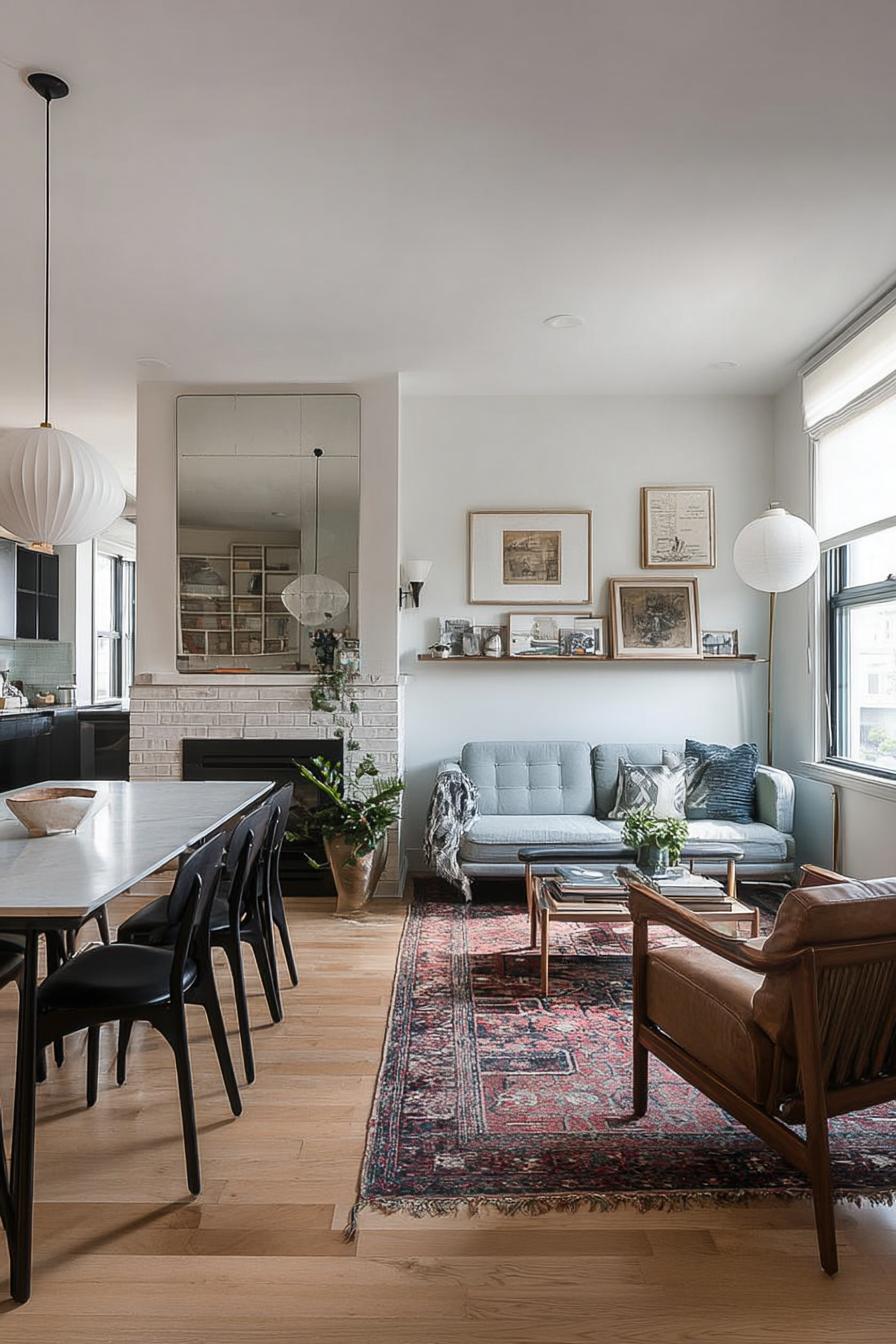
A well-worn Persian rug acts like a conductor’s baton, orchestrating color harmony throughout your space. The deep blues might reappear in throw pillows, while burnt orange threads inspire dining chair upholstery choices.
These rugs carry stories in their fibers – previous owners, distant bazaars, countless footsteps – adding soul to newly combined spaces.
Let the rug’s palette guide your accent choices, pulling specific hues for artwork, vases, or bookshelf styling. Ready to commit? Visit estate sales or vintage shops where these treasures often hide, waiting for their next chapter.
9. Incorporate Textured Rugs to Define Each Area in Small Apartment

Building on the Persian rug concept, consider using different textures rather than patterns to distinguish zones. A plush shag rug under your coffee table contrasts beautifully with a flat-weave kilim beneath your dining set – your feet instantly know which room they’ve entered.
The textural variety adds depth without introducing competing patterns that might overwhelm compact quarters.
This tactile approach seems particularly effective in studio apartments where every square inch counts. Will you choose nubby jute for dining and velvet-soft wool for lounging, or perhaps reverse that combination?
10. Anchor the Living Space with a Large Center Coffee Table For Apartment
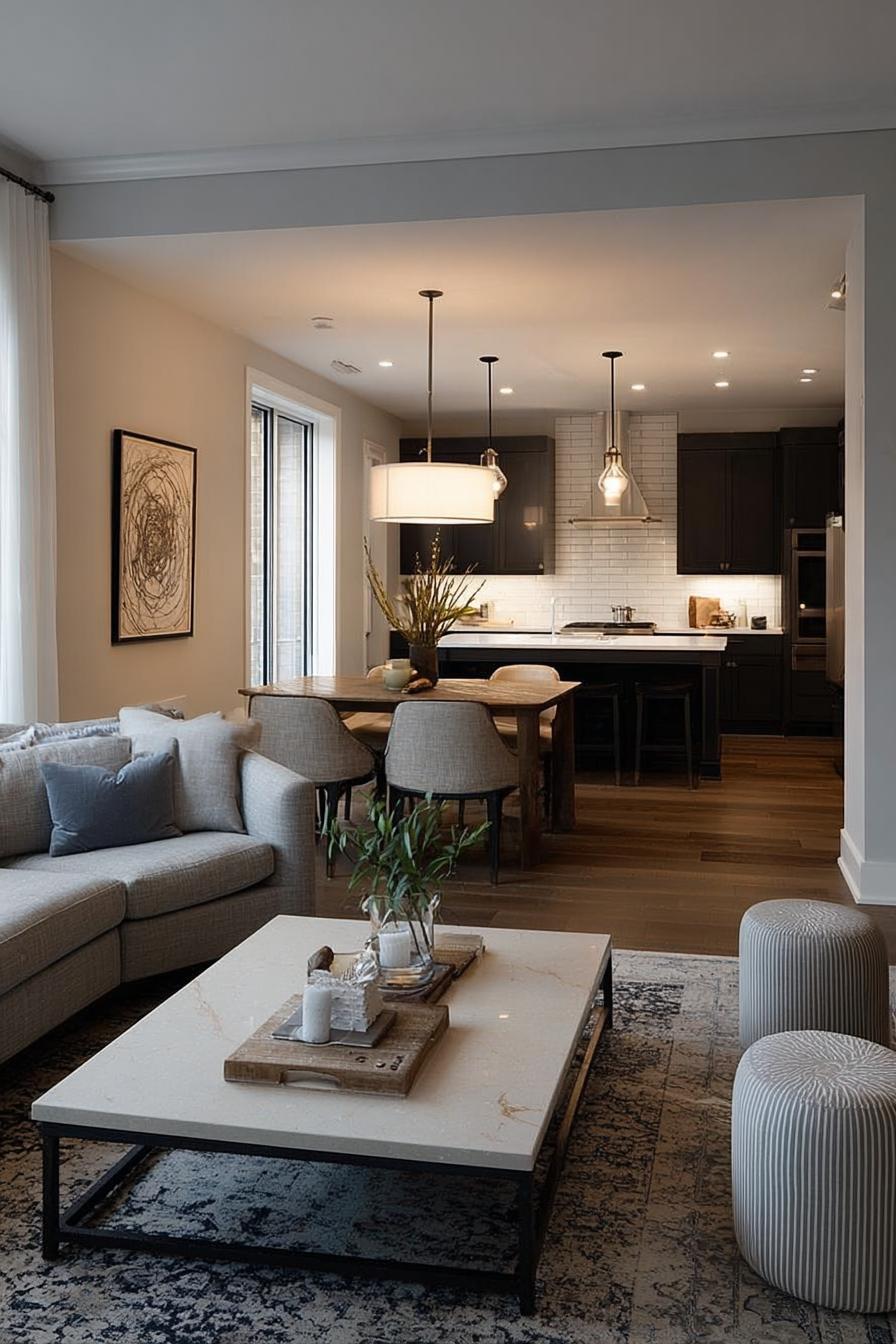
The oversized coffee table trend shows no signs of retreating – and for good reason. A substantial piece grounds your seating area while providing surface space for everything from morning laptops to evening appetizer spreads. Think of a reclaimed wood slab or marble-topped masterpiece that commands attention without demanding it.
In practice, this might mean choosing a 60-inch table where you’d traditionally place a 40-inch version. The extra surface eliminates those awkward reaches across gaps, creating a more intimate conversation zone even in spacious layouts.
11. Balance Soft Gray Tones with Warm Wooden Furniture For Modern Decor
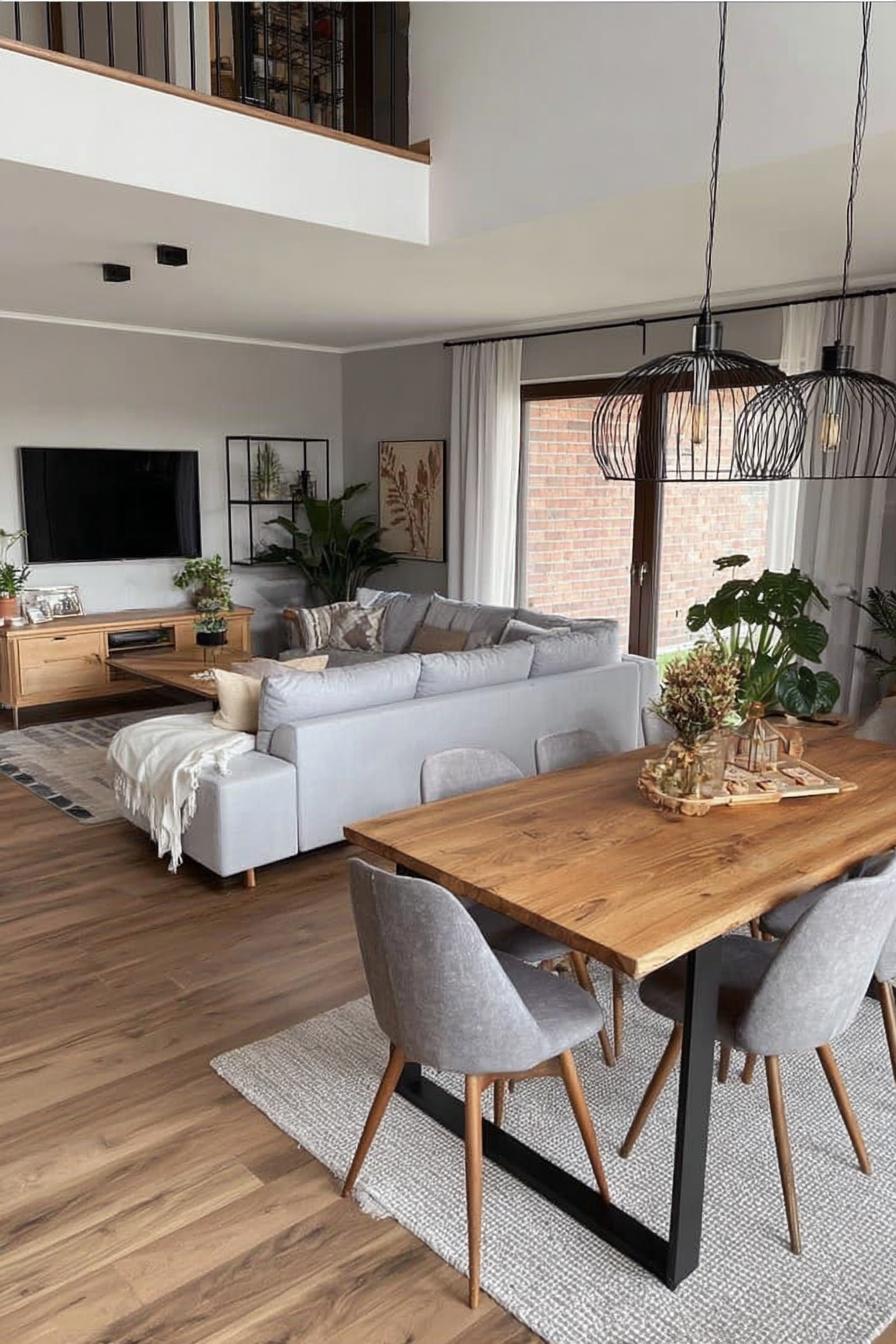
Surprisingly, the coolness of gray walls makes wooden furniture appear even warmer – like firelight against winter skies. This temperature contrast creates visual interest without relying on bold colors or busy patterns. The combination feels sophisticated yet approachable, formal enough for dinner parties but relaxed enough for Sunday pancakes.
Choose wood tones that lean amber or honey rather than red; these shades complement gray’s undertones better. A final touch: add one unexpected warm element – perhaps a cognac leather chair or brass lamp – to prevent the space from feeling too calculated.
12. Transform Your Living-Dining Room with White Furniture
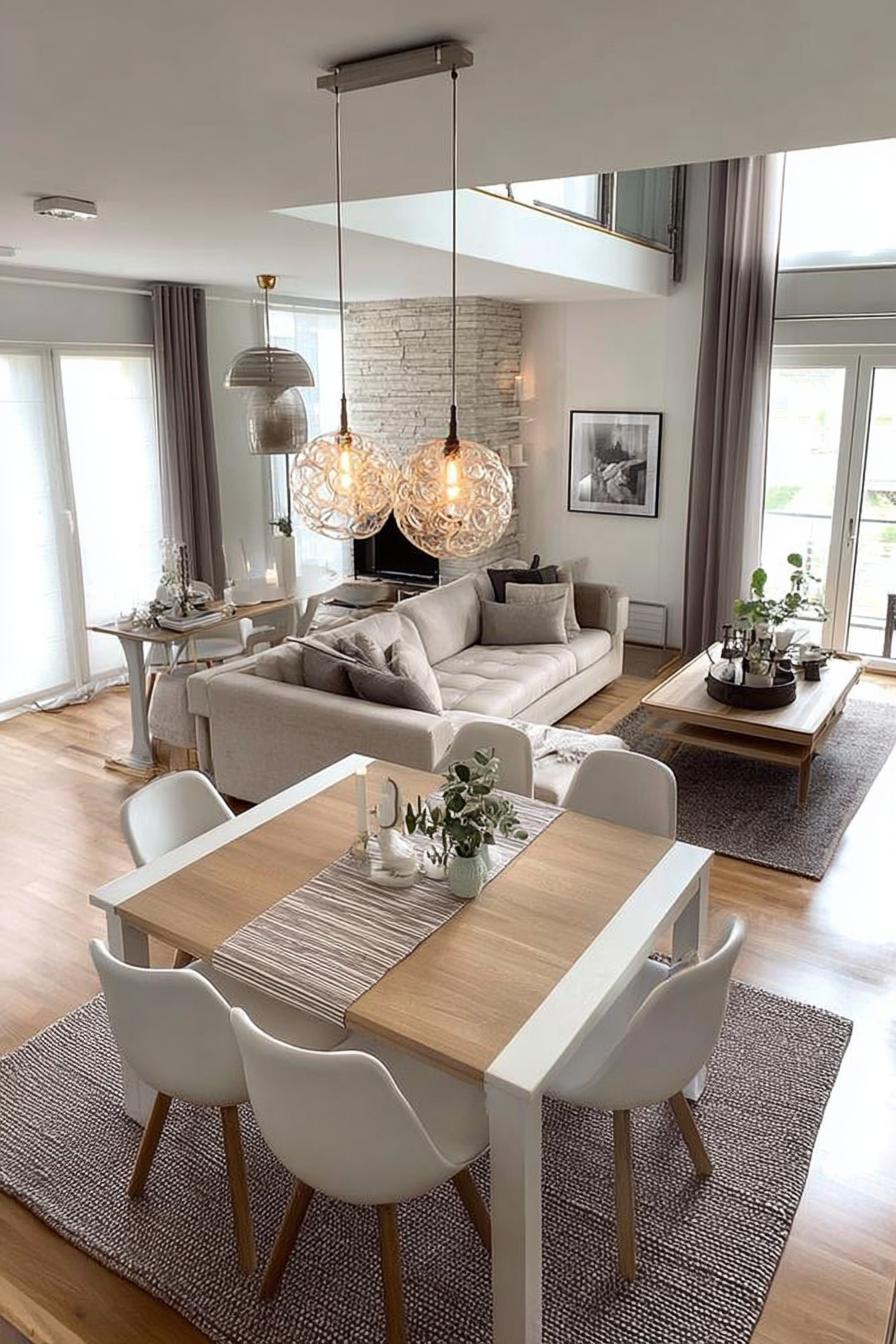
A living-dining room combination works beautifully with white furniture. White tones reflect natural light, making the space feel brighter, larger, and more open.
A sleek white dining table paired with matching chairs blends seamlessly into the room, while a white sofa or sideboard enhances the airy atmosphere.
Adding glass, mirrors, or light wood accents keeps the look warm and inviting without losing the spacious effect. This minimalist approach maximizes light, visually expands the area, and creates a calm, modern ambiance that feels both elegant and comfortable.
13. Integrate Woven Pendant Lights to Enhance Warm Lighting

Here’s something unexpected: woven fixtures actually originated from fishing communities who repurposed nets and baskets as lampshades. Today’s rattan and bamboo pendants cast intricate shadows that transform blank walls into temporary art installations.
These organic shapes soften the hard edges typical in modern floor plans, introducing curves where architecture provides only angles.
The natural materials complement virtually any color scheme, though they sing especially well with earth tones and botanicals. Beware of hanging these too low in high-traffic areas – their delicate weaves don’t appreciate head bumps or shoulder brushes.
14. Maximize Comfort with Coordinated Neutral Sofa and Cushions For Apartment

Forget what minimalists preach – comfort shouldn’t be sacrificed for aesthetics. Layer your neutral sofa with varying cushion sizes in complementary textures: linen, velvet, bouclé. This abundance invites lounging while maintaining sophistication through tonal restraint.
The key lies in selecting neutrals with different undertones – warm taupe, cool ivory, greenish gray – creating depth without introducing jarring contrasts.
As you build your cushion collection, it seems the magic number hovers around five for a standard three-seat sofa. This trend toward “grandmillennial” comfort suggests we’re collectively craving coziness over stark modernism.
Conclusion
Your living-dining combination holds infinite potential – each design choice shapes how you’ll experience daily life in these merged spaces. Whether you start with strategic lighting or commit to that vintage rug, remember that successful combos evolve gradually.
Test ideas with temporary solutions first, live with them for a few weeks, then invest in permanent pieces once you’ve discovered what truly enhances your lifestyle.

